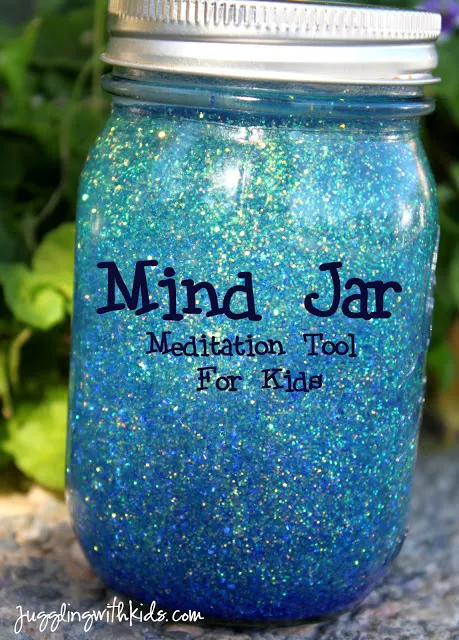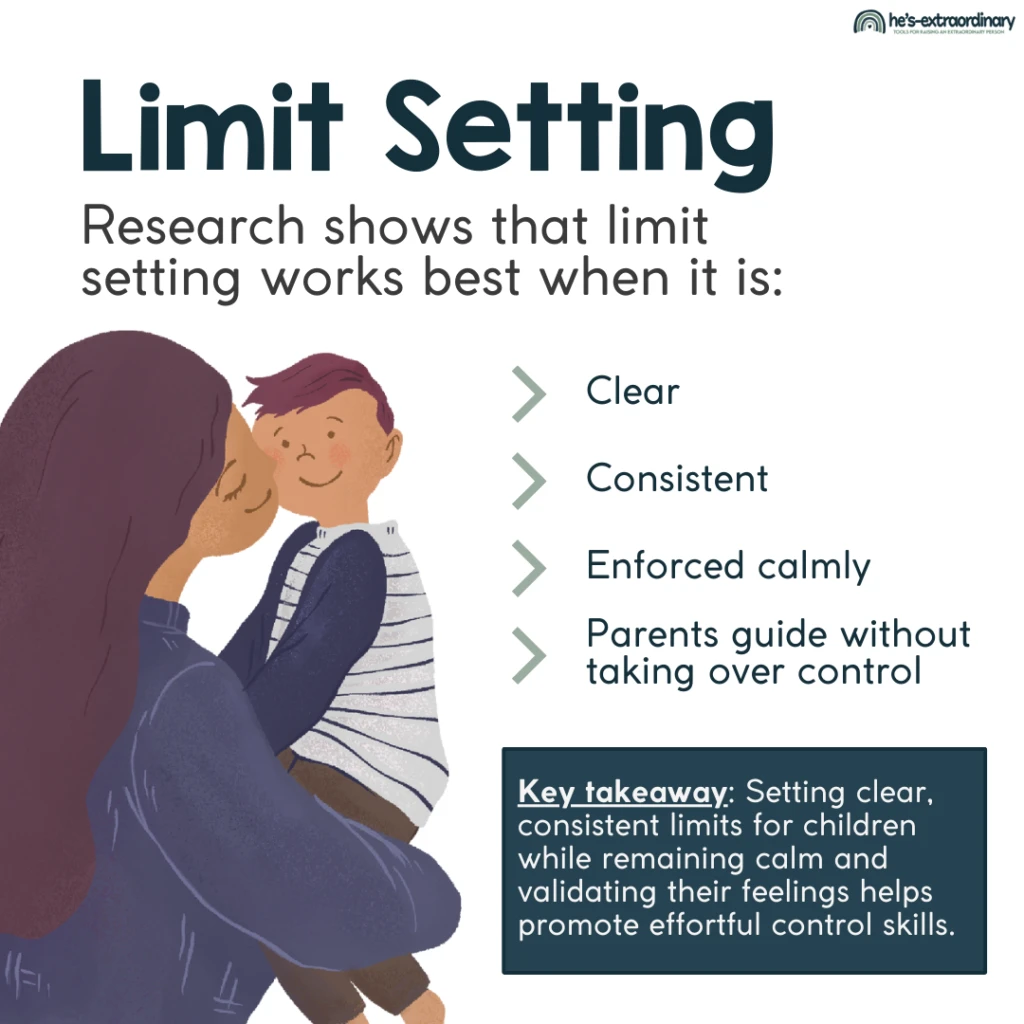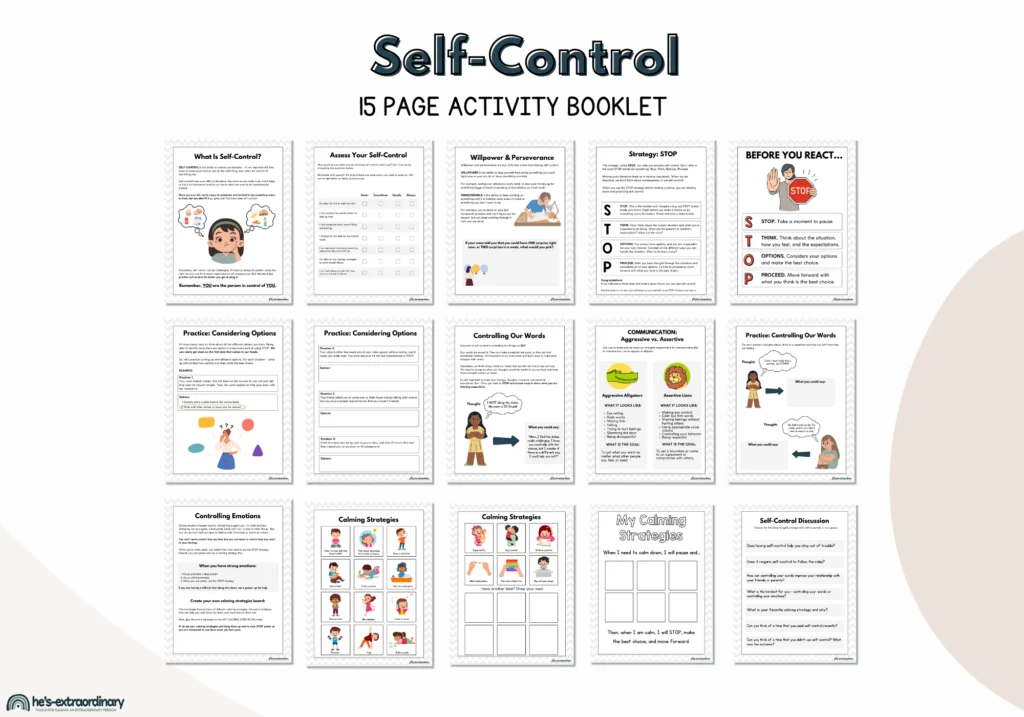What’s inside this article: A look at impulse control, signs of poor impulse control, and 10 strategies that can help develop impulse control in children with ADHD.
Disclaimer: This post contains affiliate links.

Is your child impulsive? Many children lack self-control. Impulsivity is also one of the core symptoms of ADHD, after all. So, it’s a challenge most parents encounter.
Impulse control is another one of those executive functions that are notoriously slow to develop in children with ADHD.
Executive Functions
As mentioned, impulse control is a component of executive functions. On average, children with ADHD develop their executive functions about 30% slower than their same-age peers.
For example, a 10-year-old with ADHD would developmentally have the executive functioning skills of a 7-year-old. These are all the higher-level processes in the brain – organization, time management, impulse control, emotional regulation, etc.
These lagging skills are most often the cause of the behavioral issues you and your child encounter.
It’s important to be aware of this delay because your expectations for your child should match what they are developmentally capable of.
So you shouldn’t necessarily expect your 10-year-old to have the time management abilities of other 10-year-olds.
You should, however, encourage them to practice and develop these skills regularly.
What does poor impulse control look like?
It takes on many forms, depending on your child’s personality.
Here are some examples of impulsivity.
- Struggles with taking turns
- Blurts out answers
- May run into the street without looking for oncoming traffic
- Interrupts others
- Climbs on furniture, ledges, etc.
- Emotional outbursts when things don’t go as planned
- Impatient
- Can’t wait at a table (in a restaurant, for example) for their food to arrive
- When you tell them to “Stop” anything, they can’t stop
If your child’s impulsivity is interfering with their daily life, for example, they’re getting in trouble at school or getting into conflicts with siblings or peers, then it’s time to start working on improving impulse control.
Impulse Control Activities & Practice
The key to improving any skills is regularly practicing. The more often your child is in situations where they must try to exercise their impulse control, the better they will become at doing so.
It’s important to give your child lots of practice in controlled situations where they are likely to be successful. Over time, they’ll become better at using this skill in other situations, too.
Try some of these impulse control activities to give your child more opportunities to practice this important skill.
1. Teach Self-Monitoring
It’s hard for children to practice impulse control if they aren’t aware of their thoughts, feelings, and actions. They must be able to identify what they are experiencing and what they’re feeling.
One way to improve this inner awareness in children is to work on their interoception.
You can help develop interoceptive awareness in a variety of ways. This includes mindfulness, specific stretches and exercises, breathing activities, etc.
The other important part of self-monitoring is identifying and regulating emotions.
2. Impulse Control Games
Tons of children’s games require impulse control. This is a fun way to practice, and your child won’t even know they’re working on developing these skills.
- Freeze Dance
- Simon Says
- Musical Chairs
- Duck Duck Goose
- Mother May I?
- Red Light Green Light
3. Long-Term Reward Charts
A lot of reward charts used in school are to provide immediate reinforcement to children – which is often necessary to help children be successful and follow expectations at school.
However, a long-term reward chart can help your child work on delayed gratification. Delayed gratification requires willpower which is a different level of impulse control because they need to think ahead to a future reward for meeting some longer-term goal.
For example, at school, my son has a chart; he has to get 150 check marks on the chart to earn a large reward. In a typical day, he can potentially earn around 10 – 15 checkmarks. That’s if he follows all the expectations on the chart. So it takes some time for him to earn his big reward.
You can use this concept at home as well by creating a long-term incentive chart with a highly motivating reward.
4. Stop, Relax & Think
The impulse control board game – Stop Relax & Think helps teach impulse control to children ages 6-12.
The children move through the sections of the game board, collecting chips along the way. The manual includes instructions for parents about how behaviors learned in the game can be generalized for the home or classroom.
It’s often used by therapists and counselors, but it’s available on amazon.
5. Mindfulness
There are many ways to use mindfulness to improve symptoms of ADHD.
Mind Jar
One of my favorites is the mind jar from Juggling with Kids.
You can relate this to mindfulness by explaining to your child that our thoughts and feelings are just like glitter – when we are upset, they spin all over the place inside our heads. We need them all to settle before we can calm down.
This is helpful for impulse control because as your children gain a better understanding of their thoughts and emotions, they’ll learn to recognize racing thoughts and know that if they can pause and wait, those thoughts will settle. They can calm down and think before acting.
Find instructions at: Juggling for Kids

6. Practice Waiting
Waiting is probably one of the hardest things in the world for kids. Actually, a lot of adults cannot wait without growing impatient.
Practice waiting whenever you can, even if it’s just taking one moment before proceeding.
When the kids are getting “silly,” I’ll instruct everybody to do a moment of waiting. With this impulse control activity, I turn the timer on for 60 seconds, and everyone must sit quietly.
If there are interruptions, we restart. At the end of the minute, everyone takes turns stating what they heard.
Also, teach your child ways to pass that time while they wait. Things like I Spy, reading, portable activities, etc.
Practicing this lost art of waiting at home will help your child be less impulsive and more patient when you have to wait at other times. For example, in the doctor’s office, restaurant, or in a line up at the store.
Games to Play While You Wait
Try playing these games while you wait. Practice waiting and playing these games at home.
Then, use them in real situations – preparing your child beforehand. They will be less likely to act impulsively if they know to expect a wait and they know what to do while waiting.
Check out this list: 79 Games to Play While Waiting in Line
7. Clear Expectations and Consequences
When the expectations and consequences are crystal clear, it’s easier for children to develop impulse control.
One component of impulse control is foresight – the ability to think about the probable outcome of one’s actions. Kids notoriously have poor foresight anyway, especially children with ADHD.
It might not help immediately, but if there’s any doubt what a consequence could be, this will be even more difficult.
I recommend having 5 or 6 “Family Rules” that your child helps you create. These should be on display in your home, with very clear consequences as well.
Then, use very consistent language with your child every time. For example, “Saying ‘I hate you’ is very disrespectful. One of our family rules is always to respect each other. When you can’t respect the people around you, you need to spend time alone in your room”
Then, use that same language any time they’re disrespectful. “Slamming the door is very disrespectful. One of our family rules is to always respect each other. When you can’t respect the people around you, you need to spend time alone in your room”

8. Monitor Your Own Impulse Control
Children notice everything we say and do. They’re also more likely to imitate and repeat the things we do. It’s important to set a good example of what impulse control looks like by modeling the correct behavior to our children.
Carefully monitor your actions when things become tense. When we are stressed, we’re more likely to act impulsively, too.
- If an argument with your spouse is heated or tense, take a slow, deep breath before responding so you don’t blurt anything out in anger.
- Have a designated “cool down” spot that you go to calm down when you’re overwhelmed for any reason. Use your cool-down spot whenever you need to.
- Talk about your feelings with your child regularly. For example, say ” I’m overwhelmed and I need to calm down. I’m going to the cool-down spot.”
- If your child misbehaves, don’t immediately react, especially with yelling. Instead, pause for a moment (or take several minutes in your cool-down spot), and then address the behavior calmly and directly.
- If you do show poor impulse control in front of your child, acknowledge it and apologize if necessary. Also, talk to your child about what you could have done differently.
9. Ensure Sensory Needs Are Met
One of the reasons children act impulsively – especially with behavior like running, climbing, shoving, etc is because they’re seeking sensory input.
By making sure children have lots of physical activity each day, you can help reduce this impulsivity, hyperactivity, and fidgeting.
These are my top resources for sensory input:
- 7-Minute HIIT for kids
- Proprioceptive Input Activities
- Kids Morning Workout
- Vestibular Input Activities
10. Self-Control Booklet
This booklet contains 14 pages of activities, strategies, and guides to help children develop impulse control. This is an adult-led activity, so ideally, you’d read through everything with your child and have a discussion about what you’re reading.
There’s a self-assessment tool, some discussion questions, a cut-and-paste activity to create your own calming strategies poster, and also some materials for controlling your words and your emotions.


Time-In vs. Time-Out - What Should You Use? - Positive Discipline
Saturday 19th of October 2019
[…] skills” fall in the area of executive functions. Things like problem-solving skills, impulse control, emotional regulation, cognitive flexibility, organization, stress tolerance, […]
5 Signs Your ADHD Treatment is Working & 4 Signs That It's Not
Monday 14th of October 2019
[…] your child’s ADHD treatment plan is working well, your child will be less impulsive, both behaviorally and […]
What Are Executive Functions? How Can You Build Them?
Wednesday 28th of August 2019
[…] Self-restraint […]